In the PROMOTIONS table, the PROMO_ BEGIN_DATE column is of data type and the default date format is DD-MON-RR
Which two statements are true about expressions using PROMO_ BEGIN_DATE in a query?
Examine the description of the ORDER_ITEMS table:
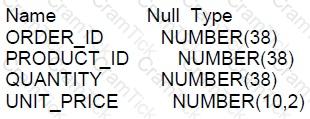
Examine this incomplete query:
SELECT DISTINCT quantity * unit_price total_paid FROM order_items ORDER BY
Which two can replace
Table HR.EMPLOYEES contains a row where the EMPLOYEES _ID is 109.
User ALICE has no privileges to access HR.EMPLOYEES.
User ALICE starts a session.
User HR. starts a session and successfully executes these statements:
GRANT DELETE ON employees TO alice;
UPDATE employees SET salary = 24000 WHERE employee_id = 109;
In her existing session ALICE then executes:
DELETE FROM hr.employees WHERE employee_id = 109;
What is the result?
Examine the description of the EMPLOYEES table:

The session time zone is the same as the database server
Which two statements will list only the employees who have been working with the company for more than five years?
The INVOICE table has a QTY_SOLD column of data type NUMBER and an INVOICE_DATE column of data type DATE NLS_DATE_FORMAT is set to DD-MON-RR.
Which two are true about data type conversions involving these columns in query expressions?
Examine the description of the transactions table:
Which two SQL statements execute successfully?
Examine this query:
SELECT INTERVAL '100' MONTH DURATION FROM DUAL;
What will be the output?
Examine the description of the sales table.
The sales table has 55,000 rows.
Examine this statements:
Which two statements are true?
You want to write a query that prompts for two column names and the WHERE condition each time It is executed in a session but only prompts for the table name the first time it is executed. The variables used in your
query are never undefined in your session . Which query can be used?
Which two statements are true about the results of using the intersect operator in compound queries?
which three statements are true about indexes and their administration in an Oracle database?
Examine the description or the BOOKS_TRANSACTIONS table:

FOR customers whose income level has a value, you want to display the first name and due amount as 5% of their credit limit. Customers whose due amount is null should not be displayed.
Which query should be used?
Examine the data in the CUST_NAME column of the CUSTOMERS table:
CUST_NAME
---------------------
Renske Ladwig
Jason Mallin
Samuel McCain
Allan MCEwen
Irene Mikkilineni
Julia Nayer
You want to display the CUST_NAME values where the last name starts with Mc or MC.
Which two WHERE clauses give the required result?
MANAGER is an existing role with no privileges or roles.
EMP is an existing role containing the CREATE TABLE privilege.
EMPLOYEES is an existing table in the HR schema.
Which two commands execute successfully?
Examine the description of the PRODUCT_ DETAILS table:

Which two statements are true?
Examine these two queries and their output:
SELECT deptno, dname FROM dept;

SELECT ename, job, deptno FROM emp ORDER BY deptno;
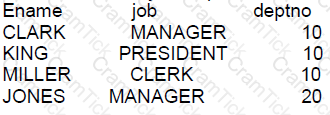
Now examine this query:
SELECT ename, dname
FROM emp CROSS JOIN dept WHERE job = 'MANAGER'
AND dept.deptno IN (10, 20) ;
Examine the data in the NEW_EMPLOYEES table:
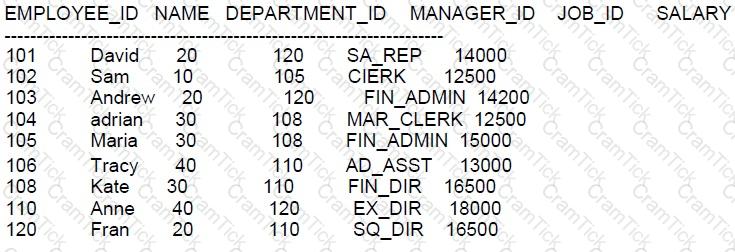
Examine the data in the EMPLOYEES table:

You want to:
1. Update existing employee details in the EMPLOYEES table with data from the NEW EMPLOYEES
table.
2. Add new employee detail from the NEW_ EMPLOYEES able to the EMPLOYEES table.
Which statement will do this:
Examine this partial query:
SELECT ch.channel_type, t.month, co.country_code, SUM(s.amount_sold) SALES
FROM sales s, times t, channels ch, countries co
WHERE s.time_ id = t.time id
AND s.country_ id = co. country id
AND s. channel id = ch.channel id
AND ch.channel type IN ('Direct Sales', 'Internet')
AND t.month IN ('2000-09', '2000-10')
AND co.country code IN ('GB', 'US')
Examine this output:
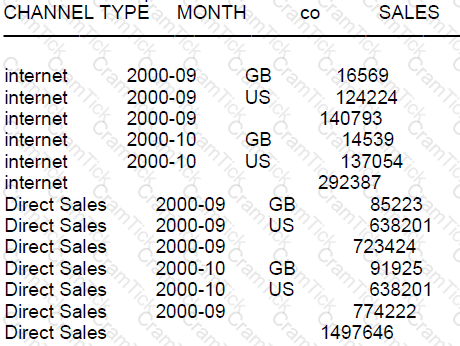
Which GROUP BY clause must be added so the query returns the results shown?
The SYSDATE function displays the current Oracle Server date as:
21 -MAY-19
You wish to display the date as:
MONDAY, 21 MAY, 201 9
Which statement will do this?
Examine this SQL statement:
SELECT cust_id, cust_last_name "Last Name
FROM customers
WHERE countryid=10
UNION
SELECT custid CUSTNO, cust_last_name
FROM customers
WHERE countryid=30
Identify three ORDER BY clauses, any one of which can complete the query successfully.
Examine this Statement which returns the name of each employee and their manager,
SELECT e.last name AS emp,,m.last_name AS mgr
FROM employees e JOIN managers m
ON e.manager_ id = m. employee_ id ORDER BY emp;
You want to extend the query to include employees with no manager. What must you add before JOIN to do this?
Examine the description of the PRODUCTS table:

Which two statements execute without errors?
Examine these statements which execute successfully:
ALTER SESSION SET NLS_DATE_FORMAT = ‘DD-MON-YYYY HH24 MI: SS’
ALTER SESSION SET TIME_ ZONE = ‘-5:00’;
SELECT DBTIMEZONE, SYSDATE FROM DUAL
Examine the result:

If LOCALTIMESTAMP was selected at the same time what would it return?
Examine the description of the SALES1 table:
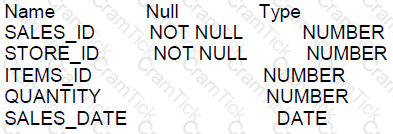
SALES2 is a table with the same description as SALES1,
Some sales data is duplicated In both tables.
You want to display the rows from the SALES1 table which are not present in the SALIES2 table.
Which set operator generates the required output?
Examine the description of the PRODCTS table which contains data:

Which two are true?
View the Exhibit and examine the structure of the ORDERS table.
The columns ORDER_MODE and ORDER TOTAL have the default values'direct “and respectively.
Which two INSERT statements are valid? (Choose two.)
Examine the description of the SALES table:
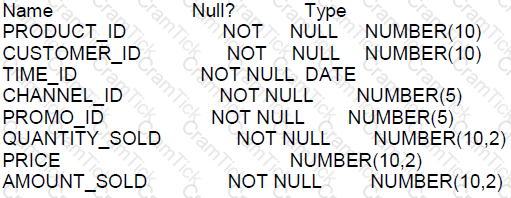
The SALES table has 5,000 rows.
Examine this statement:
CREATE TABLE sales1 (prod id, cust_id, quantity_sold, price)
AS
SELECT product_id, customer_id, quantity_sold, price
FROM sales
WHERE 1=1
Which two statements are true?
Examine this query:
SELECT TRUNC (ROUND(156.00,-2),-1) FROM DUAL; What is the result?
Examine the data in the INVOICES table:

Examine the data in the CURRENCIES table:
CURRENCY_CODE
-------------
JPY
GPB
CAD
EUR
USD
Which query returns the currencies in CURRENCIES that are not present in INVOICES?
Which four statements are true regarding primary and foreign key constraints and the effect they can have on table data?
Evaluate these commands which execute successfully CREATE SEQUENCE ord_seq
INCREMENT BY 1
START WITH 1
MAXVALUE 100000
CYCLE
CACHE 5000;
Create table ord_items(
ord_no number(4) default ord_seq.nextval not null,
Item_no number(3),
Qty number(3),
Expiry_date date,
Constraint it_pk primary key(ord_no,item_no),
Constraint ord_fk foreign key (ord_no) references orders(ord_no));
Which two statements are true about the ORD_ITEMS table and the ORD_SEQ sequence?
You execute this query:
SELECT TO CHAR (NEXT_DAY(LAST_DAY(SYSDATE),’MON’ ),’ dd“Monday for” fmMonth rrr’) FROM DUAL;
What is the result?
Examine the data in the COLORS table:

Examine the data in the BRICKS table:

Which two queries return all the rows from COLORS?
Which three statements are true about defining relations between tables in a relational database?
Examine this statement which executes successfully:
CREATE view emp80 AS
SELECT
FROM employees
WHERE department_ id = 80
WITH CHECK OPTION;
Which statement will violate the CHECK constraint?
The SALES table has columns PROD_ID and QUANTITY_SOLD of data type NUMBER. Which two queries execute successfully?
Examine the description of the ENPLOYES table:
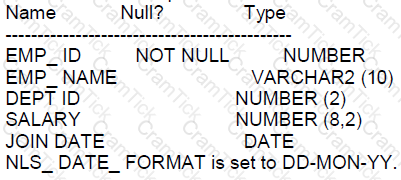
Which query requires explicit data type conversion?
Examine the description of the ORDERS table:
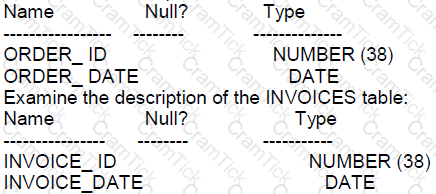
Which three statements execute successfully?
Examine this statement which executes successfully:
Which statement will violate the CHECK constraint?
The ORDERS table has a column ORDER_DATE of date type DATE The default display format for a date is DD-MON-RR
Which two WHERE conditions demonstrate the correct usage of conversion functions?
Which three statements are true about sequences in a single instance Oracle database?
Examine these statements:
CREATE TABLE dept (
deptno NUMBER PRIMARY KEY,
diname VARCHAR2(10) ,
mgr NUMBER ,
CONSTRAINT dept_fkey FOREIGN KEY(mgr) REFERENCES emp (empno));
CREATE TABLE emp (
Empno NUMBER PRIMARY KEY,
Ename VARCHAR2 (10) ,
deptno NUMBER,
CONSTRAINT emp_fkey FOREIGN KEY (deptno) REFERENCES dept (deptno) DISABLE);
ALTER TABLE emp MODIFY CONSTRAINT emp_fkey ENABLE;
Which two are true?
Examine the description of the CUSTOMERS table:

You want to display details of all customers who reside in cities starting with the letter D followed by at least two character.
Which query can be used?
The CUSTOMERS table has a CUST_CREDT_LIMIT column of data type number.
Which two queries execute successfully?
Which three statements are true about time zones, date data types, and timestamp data types in an Oracle database?
Examine the description of the CUSTOMERS table:

Which three statements will do an implicit conversion?
Which statements are true regarding primary and foreign key constraints and the effect they can have on table data?
Oracle PL | 1z0-071 Questions Answers | 1z0-071 Test Prep | Oracle Database 12c SQL Questions PDF | 1z0-071 Online Exam | 1z0-071 Practice Test | 1z0-071 PDF | 1z0-071 Test Questions | 1z0-071 Study Material | 1z0-071 Exam Preparation | 1z0-071 Valid Dumps | 1z0-071 Real Questions | Oracle PL 1z0-071 Exam Questions